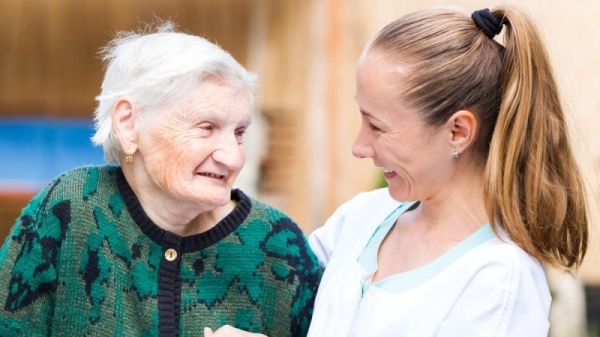Migrant workers keep German care system afloat, say experts

The German health and old-age care system is dependent on migrant workers, according to experts, with 690,000 people born in another country working in the sector.
With an ageing population whose demand for care is growing steadily, and with labour shortages already abundant, migrant workers form an essential part of the German care sector.
“Without immigrant professionals at all levels of the health system, as the COVID-19 pandemic has shown at the latest, the German health system would face a collapse,” a report by the German Expert Council on Integration and Migration reads.
Of 4.2 million people working in the German health and care sector as a whole, 690,000 have been born abroad, according to the expert council.
While foreign-born workers are spread across all kinds of medical professions, from doctors and nurses to supporting and more administrative professions, the highest share is recorded among elderly care workers, where 25% of all workers have migrated from abroad.
Most elderly people with a need for care are provided for in their own homes, not in stationary facilities such as nursing homes. But with traditional multi-generation households declining, demand for support by external personnel is high.
The biggest group of migrants in the German care sector thus operates in a legal grey area, so-called live-in care, which means they go directly into the homes of the elderly and support their families in caring for their elder relatives at home.
While exact numbers are unknown, estimates range from 300,000 to 700,000 migrants working in such an arrangement.
Often, the families are promised 24-hour support for their elderly relatives by placement agencies, but “this is not even possible in a legal way”, explained Justyna Oblacewicz of “Faire Mobilität”, a helpdesk funded by the German government and trade unions to legally advise affected workers.
While on paper, workers would often have a legal form of employment, either through the rules of the EU’s Posted Workers Directive or by being self-employed in their home country, “you have a completely different reality that is lived but not recorded anywhere,” Oblacewicz told EURACTIV.
While contracts would often only cover a weekly working time of 30 to 40 hours, workers would be expected to be available around the clock for potential emergencies.
As confirmed by a ruling of the Federal Labour Court in 2021, however, this would also count as working time and thus would need to be remunerated with at least the minimum wage – something that, in practice, is usually not the case.
Eastern Europe main region from where workers come
Most of the workers operating in households directly are women above the age of 50, coming from Central and Eastern European countries, Oblacewicz said.
The main countries of origin are Poland, Romania and Slovakia, the expert council notes.
But while EU nationals make the lion’s share of affected workers, an increasing number of non-EU nationals would also work under such arrangements, Oblacewicz said, citing Ukraine and Serbia as examples.
This reflects the overall pattern in migration for medical and care-related professions, with the biggest groups of immigrant workers in Germany coming from countries which joined the EU in or after 2004 as well as other, non-EU countries in Eastern Europe.
Unlike medical or care professionals in stationary care homes, who need to get their foreign qualifications recognised, workers in family households would often have no medical or care-specific qualification, the expert said.
“The problem is that often no special qualifications are required, which means that recruitment works in such a way that they can be recruited within a few days, and they do not have to have any nursing training,” she said.
Often, workers would not know what they should expect from the work, and thus would be overstrained quickly, Oblacewicz said.
German care system encourages care at home
The practice would also be encouraged by the workings of the German long-term care insurance system.
If the elderly are affected by certain medical conditions, such as dementia, families can choose between stationary care and a direct payment (nursing care allowance) ranging from €300-900 per month, depending on the medical conditions of the affected person.
The expert council noted that 80% would choose the option to care for their relatives at home.
Thereby, the payment from the long-term care insurance can be used to partly pay for the monthly fees of live-in care agencies, large parts of which typically stay with the agencies, instead of reaching the workers.
“The problem is that the nursing allowance is used to support such business models, which in case of doubt are dubious,” Oblacewicz said.



